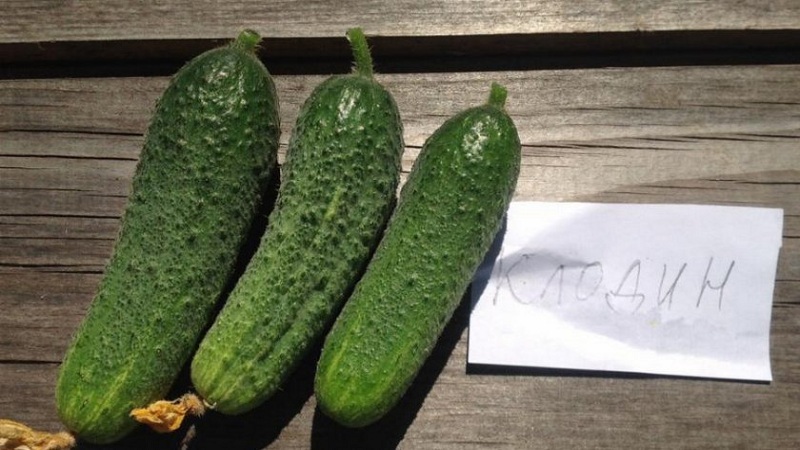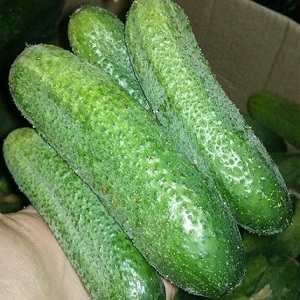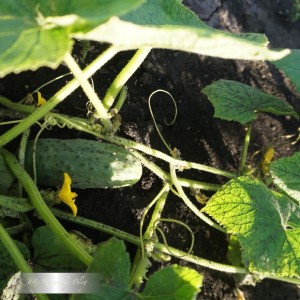Parthenocarpic hybrid of cucumbers "Claudine f1" from Dutch breeders
Cucumbers Claudine f1 is an early ripe parthenocarpic hybrid characterized by high productivity, a long fruiting period and unpretentiousness to growing conditions. This is an improved form of the previously popular Dutch hybrid Claudia f1. Small fruits with a refreshing taste and thin skin - "Dutch shirt" with white thorny thorns - are ideal for fresh consumption.
In this article, we will talk about the basic techniques of cultivating cucumbers, their advantages and disadvantages.
The content of the article
Description of the hybrid
Cucumber Claudine f1 is a product of selective work of biologists of the Dutch company Monsanto. The hybrid was included in the State Register of Selective Achievements of Russia in 2008. The culture is suitable for growing in all regions of the country in open ground, greenhouses and tunnels.
The plant is indeterminate, medium-sized, with dense foliage, female type of flowering and tuft ovary. Up to seven zelents are formed in one node. Fertilization and development of fruits occurs without the participation of pollen - that is, insects are not required for pollination of flowers.
Pictured is a Claudine f1 hybrid.

Distinctive features of the hybrid are presented in the table.
| Indicators | Characteristic |
| Ripening period | 38-40 days from the moment of emergence |
| Pollination type | Parthenocarpic |
| Weight | 85-100 g |
| Length | 10-11 cm |
| The form | Cylindrical |
| Coloration | Dark green |
| Leaves | Medium green |
| Pulp | Dense, crispy, no voids |
| Taste | Excellent, no bitterness |
| Skin | Thin, small tuberous, with dense white pubescence |
| Appointment | Salad |
| Yield | 9-10 kg / m² |
| Sustainability | To cucumber mosaic virus, powdery mildew |
| Transportability | Average |
Composition, nutritional value and useful properties
Nutritional value of cucumbers (per 100 g):
- calorie content - 14 kcal;
- proteins - 0.8 g;
- fats - 0.1 g;
- carbohydrates - 2.5 g;
- water - 95 g;
- fiber - 1 g.
Vitamin and mineral composition table
| Vitamins | Minerals |
| Vitamin A | Calcium |
| Vitamin B1 | Silicon |
| Vitamin B2 | Potassium |
| Vitamin B4 | Sodium |
| Vitamin B5 | Magnesium |
| Vitamin B6 | Sulfur |
| Vitamin B9 | Phosphorus |
| Vitamin C | Chlorine |
| Vitamin E | Iodine |
| Vitamin H | Iron |
| Vitamin K | Manganese |
| Vitamin PP | Selenium |
| Copper | |
| Chromium | |
| Fluorine | |
| Zinc |
Benefit:
- quenches thirst;
- relieves attacks of heartburn;
- improves the digestive tract;
- restores thyroid function;
- relieves puffiness;
- whitens the skin of the face.
Agrotechnics of cucumbers
The culture is grown by seedling and sowing methods. Direct seeding in the ground is carried out in late May or early June.
Due to the poor tolerance of picking, seedlings are grown directly in peat pots. This method eliminates root trauma. Saplings are planted in prepared soil in early June.
Plant care is simple. It is enough to provide moderate watering at the beginning of the growing season, and frequent watering during the fruiting period. The culture gratefully responds to organic, nitrogen, potassium-phosphorus fertilizers.
Seedling planting
Hybrid seeds do not need additional treatment with germination stimulants and disinfecting solutions. They undergo all the necessary processing in production.
Seedlings of cucumbers painfully tolerate a pick, so the seeds are laid out in individual pots of peat or paper with a volume of 0.5 liters. Fertile and loose soil is suitable for growing strong seedlings.To prepare it, you will need 2 parts of humus, 2 parts of peat and 1 part of sawdust or river sand. The components are mixed in a deep container and spilled with a dark solution of potassium permanganate, then 25 g of nitrophosphate is added.
The pots are filled with moist soil and the seeds are placed to a depth of 1.5-2 cm, a centimeter layer of peat is poured on top. The containers are covered with polyethylene and placed in a warm, dark place.
The film is removed after germination, the containers are taken out on the windowsill from the south side.
For irrigation, use settled water at room temperature. Watering frequency is once a week.
For feeding the seedlings, ready-made fertilizers "Aquarin" or "Kemira" are used.
The seedlings are ready for transfer to a permanent place after 2-3 true leaves have formed.
Direct sowing in the ground
They begin to prepare the soil for sowing seeds in the fall: they dig up and bring in a bucket of cow humus. In the spring, the soil is loosened and fed with ammonium nitrate - 20 g, superphosphate - 30 g, potassium sulfate - 15 g per 1 m² two weeks before sowing.
The optimum soil temperature is not lower than +8 ° С, the air temperature is not lower than +10 ° С. Sowing scheme - 50x30 cm, seed placement depth - 2-3 cm.
The soil is covered with black agrofiber to protect it from frost.
Council. Sow seeds in moist soil for quick germination.
Care
Cucumber care rules:
- thinning seedlings and removing weak shoots;
- at the initial stage of vegetation, plants are watered once a week, from the moment of fruiting, the frequency is increased to 3-4 times by 2.5-3 liters per 1 m²;
- after each watering, soil is loosened and weeds are removed;
- with a delay in development, the bushes are fed with nitrogen-containing fertilizers;
- in addition to nitrogenous dressings, cucumbers are fertilized with organic matter, potassium and phosphorus;
- the crop is harvested as the greens ripen to support abundant fruiting.
Top dressing scheme:
- the first - 14 days after sowing (planting): solution of chicken manure 1:15;
- the second - during the flowering period: 10 g of ammonium nitrate, 10 g of superphosphate, 10 g of potassium salt / 10 l of water;
- the third - during the fruiting period: 25 g of potassium nitrate / 10 l or 50 g of urea / 10 l.
Reference. The infusion of wood ash (300 g per 10 l) can be used for foliar dressing during the entire growing season of cucumbers.
The nuances of growing and possible difficulties
The Claudine f1 hybrid is called the improved form of the Claudia f1 cucumber. The culture is characterized by unpretentious care, resistance to heat and cold.
Like any other bunch-type cucumber, the plant needs the correct shaping of the bushes:
- all shoots and flowers are removed from the leaf axils;
- one ovary is left in the axil of the fifth leaf;
- in the sinuses of 7-10 leaves, two ovaries are left;
- the stem is thrown over the trellis;
- pinch the top of the head 1 m from the ground.
This procedure is called "blinding". It is carried out with the aim of extending the fruiting period, improving disease resistance.
From mid-August, the bushes are spud to stimulate the growth of new roots. For replenishment, use: 1 liter of milk serum and 25-30 drops of iodine, boric acid solution (10 g / 10 liters of hot water).
Diseases and pests
Claudine cucumbers are resistant to powdery mildew and tobacco mosaic virus, tolerant to downy mildew (peronosporosis).
Signs:
- tiny brownish and yellow spots on the leaves;

- purple-gray bloom on the reverse side;
- yellowing and falling of leaves.
The reasons:
- excessive humidity and air temperature below +9 ° С;
- watering with cold water;
- increased alkali content in the soil.
For prevention:
- the soil is dug up and disinfected with copper sulfate or "Fitosporin";
- infected bushes are dug up and burned;
- the beds are regularly loosened and weeded;
- observe the rule of crop rotation.
If infection could not be avoided, they are used for treatment:
- chemical preparations: 0.5% solution of Bordeaux liquid, "Oxyhom";
- folk remedies with ash, potassium permanganate, milk whey and iodine.
Folk remedies recipes:
- 10-15 drops of iodine, 1 liter of whey, 9 liters of pure water. The bushes are processed once every 1-1.5 weeks.
- 500 g of wood ash is mixed into 1 liter of hot water and infused for 3-4 hours. Then the mixture is filtered through cheesecloth and the volume is adjusted to 10 liters. The bushes are irrigated once every seven days.
- Add 1 g of potassium permanganate to 10 liters of water and spray the bushes with a solution once every 15 days.
Insecticides help to fight the melon aphid, bear, whitefly and spider mite on the site: Fitoverm, Komandor, Aktara, Nemabaktin.
Slugs are collected by hand at night, traps are set from beer cans, tobacco shag and hot peppers are scattered on the beds, the bushes are treated with a solution of ammonia (4 tbsp. L / 10 l).
Harvesting and application of the crop
Harvesting begins about 40 days after the first shoots appear. The hybrid is amazingly productive. The fruits do not barrel, even if they are overripe on the bushes.
Cucumbers are suitable for fresh consumption, but completely unsuitable for pickles and salting because of the thin skin. They get very soft in the jar.
When assembled, cucumbers are stored for up to three weeks in a cool place.
Advantages and disadvantages
The table shows the pros and cons of the Claudine hybrid.
| Advantages | disadvantages |
| Early ripening | Seedlings do not respond well to transplanting |
| Long fruiting period | The culture is prone to downy mildew |
| The plant is resistant to heat and cold | To increase productivity, bushes need to be formed |
| The fruits are not prone to overgrowth, do not barrel, but to maintain a high level of productivity, cucumbers are harvested regularly | |
| Unpretentious care | |
| Keeping quality | |
| Excellent taste | |
| Lack of bitterness |
Reviews
The impressions of the gardeners from growing the "Dutchman" are mostly positive. They note the external similarity with the Claudius hybrid, but the taste is much higher.
Olga, Balashov: “Claudine's cucumber is my favorite. The culture is liked for its undemanding growing conditions, easy care and excellent taste. The seedlings seem weak, but after feeding with nitrogen they are actively gaining green mass. The cucumbers are delicious, juicy, the skin is thin. "
Alexander, Stary Oskol: "I have been growing this Dutch hybrid on my site for three years. For all the time with him there were no problems. Last year, the summer was cold and rainy, and the bushes were hit by downy mildew. I dealt with the problem with the help of milk whey with iodine. "
Victor, Balabanovo: “Claudine is a great hybrid for growing in a greenhouse. I form bushes as they grow, remove stepchildren and flowers, bring them into one stem. For feeding I use chicken manure, ammophos, potassium and phosphorus. The yield is consistently high until the onset of cold weather. One drawback - cucumbers are not suitable for pickling. Because of the thin skin, they become very soft. "
Read also:
An early hybrid of cucumbers "Grasshopper" from domestic breeders.
Conclusion
Claudine hybrid cucumbers have gained well-deserved popularity due to their excellent taste, ease of growing and subsequent care, high productivity and a long fruiting period. Parthenocarpic does not need additional pollination by insects, since it belongs to crops with a female type of flowering. The pollination process does not depend on male cells.
The plant is resistant to the main "cucumber" diseases, and when infected with powdery mildew, copper-containing preparations, ash, whey with iodine and potassium permanganate will come to the rescue.
The fruits are not prone to overgrowth, they have a pleasant sweetish taste, crisp flesh and thin skin.